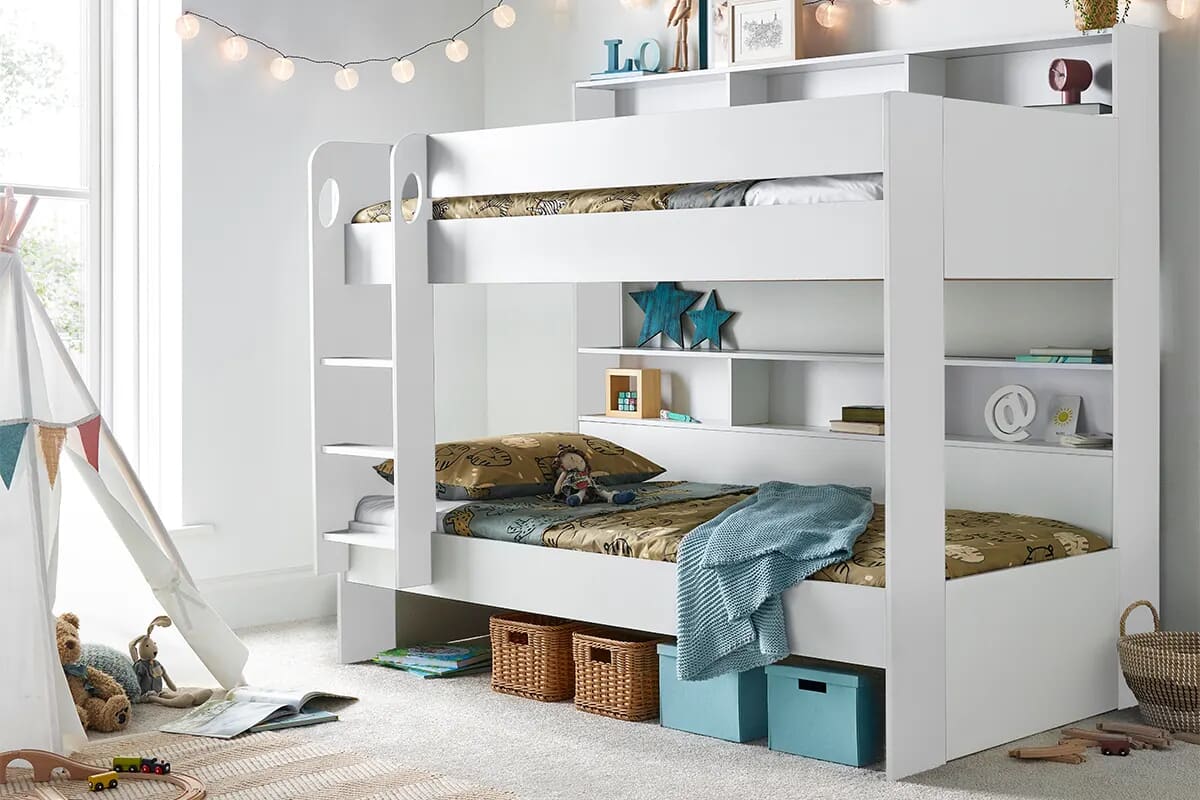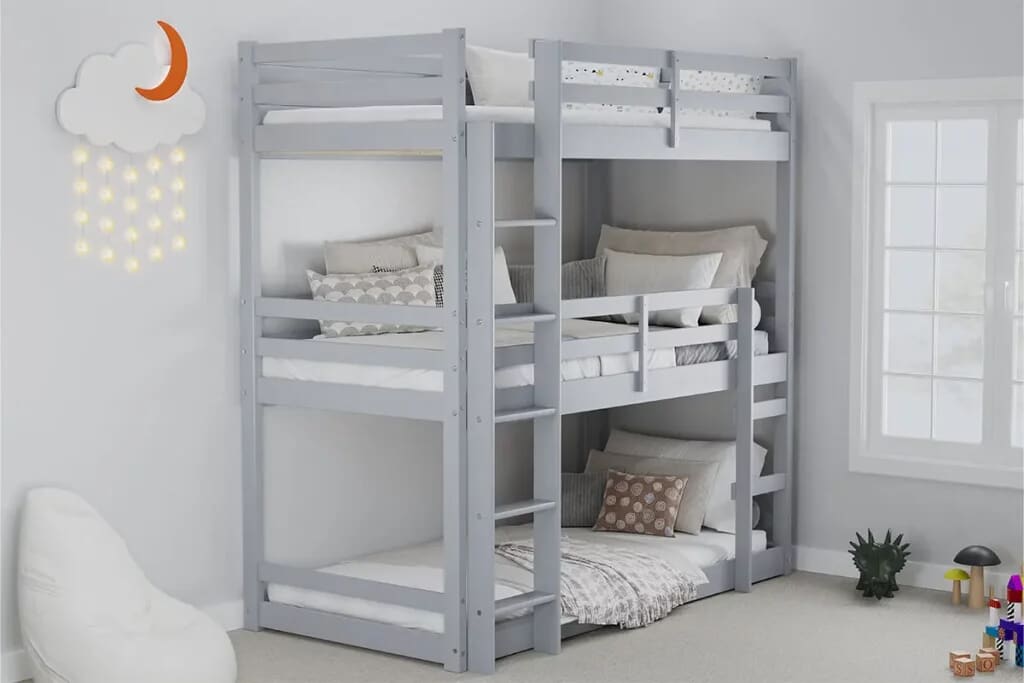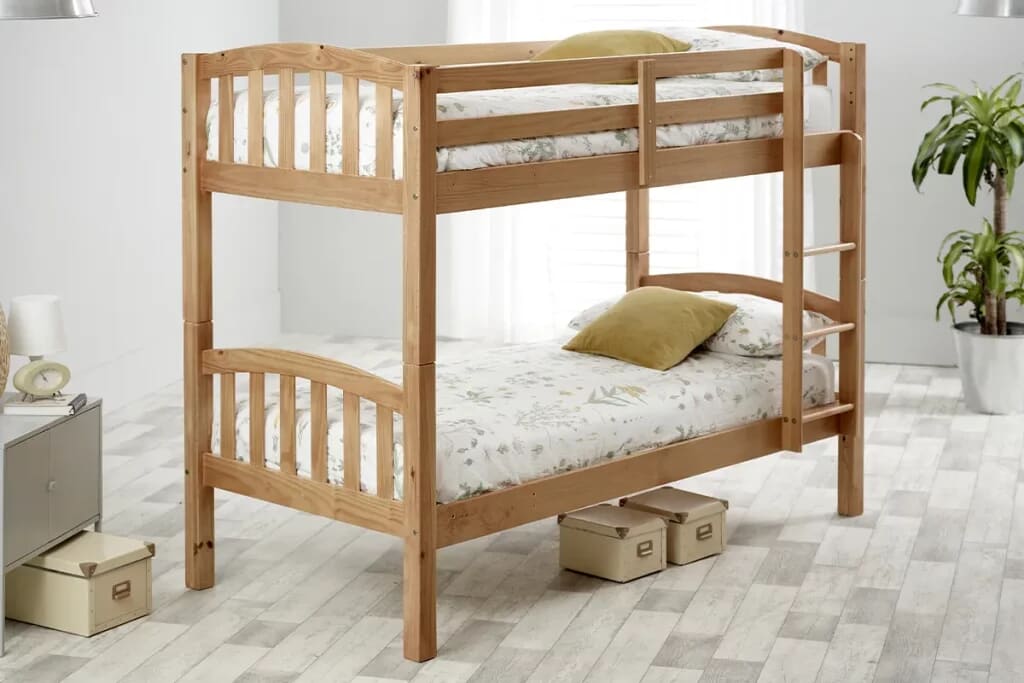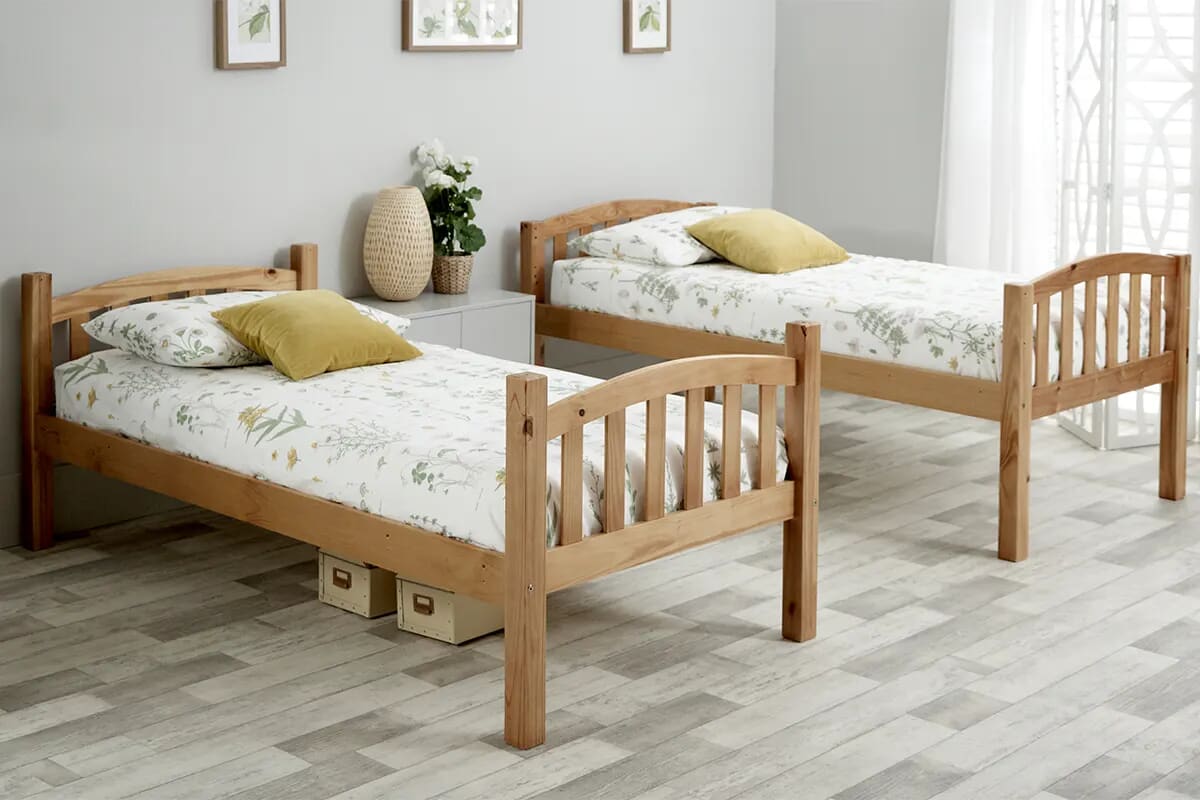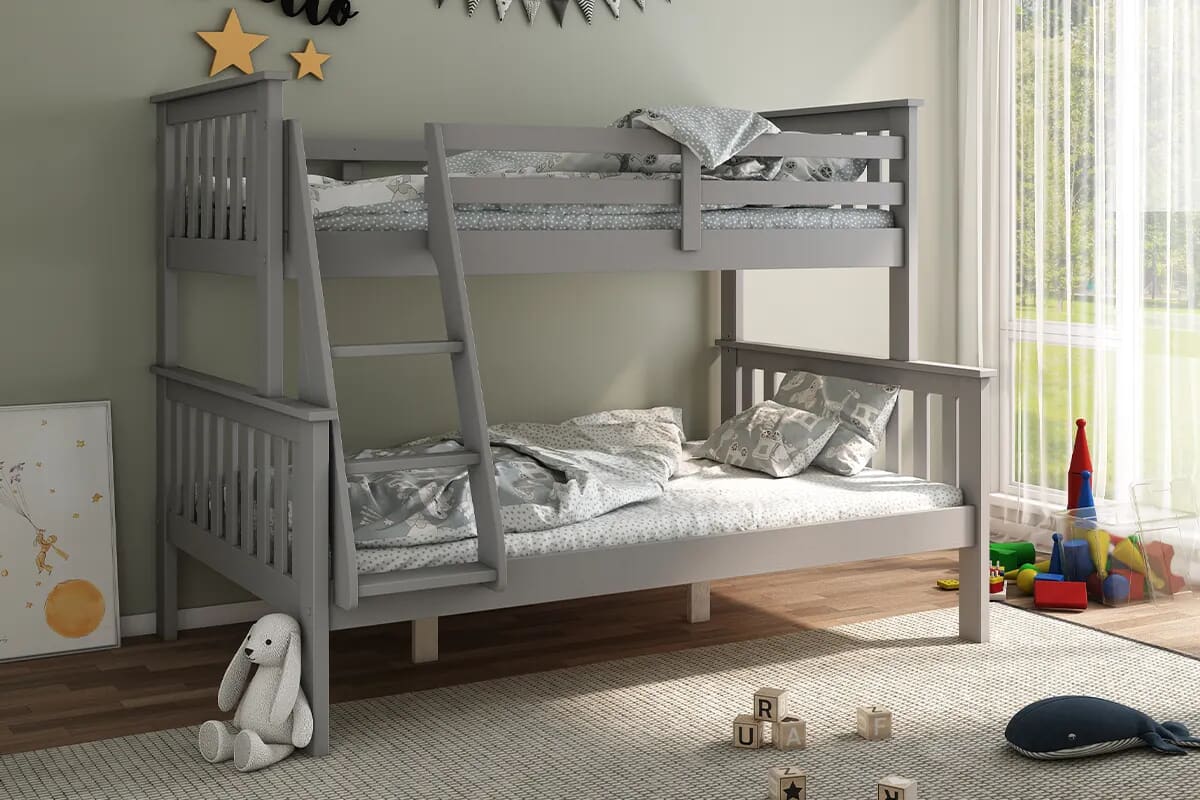Last updated: May 2025
Bunk Bed Buying Guide: How To Choose The Best Bunk Bed
Not sure how to choose the best bunk bed? We're here to help with expert tips and advice.
Space-saving, smart, and, let’s face it, great fun for kids, bunk beds are an ideal choice if you’ve got a growing family but limited room. Kid’s bunk beds are perfect for young children who share a bedroom. Or for kids who love having sleepovers with their friends.
They’re also a great fit for smaller spaces, allowing you to utilise areas such as lofts or small bedrooms, without sacrificing floor space.
But are they safe? And how do you choose the right bunk bed for your kids?
What are bunk beds?
A bunk bed is a type of bed that has one bed frame stacked on top of another bed frame. This means that you can have two beds occupying the same floor space, which makes them great for smaller spaces in rooms where multiple people sleep.
You can also get bunk beds that have storage underneath instead of another bed frame, again making good use of the available space – this is great for children’s bedrooms where they need storage for clothes and toys if they don’t have a lot of storage space elsewhere.
Are bunk beds safe?
As long as they’re constructed properly and looked after properly, bunk beds are perfectly safe. However, to make sure there are no accidents or mishaps, there are certain tips to bear in mind before you choose your bunk bed.
- Follow the instructions to the letter – when you’re building your bunk bed, follow the instructions carefully. You’ll get a step-by-step guide to constructing the frame which will give you all the information you need. You shouldn’t have any left-over nuts or bolts once you’ve finished!
- It’s a bed, not a climbing frame – as tempting as it might be for kids to play on their bunk bed, they need to know that this is a bed for sleeping in and not a climbing frame.
- Use the ladder – teach your kids to use the ladder every time they want to get up or down from the top bunk. A ladder guard may be more suitable for younger children to help them use the ladder safely.
- Position it carefully – make sure your bunk bed is well away from any windows and at least two metres away from any light fittings (including the ceiling light).
- Install a guard rail – even if your bed is hard against a wall, there will always be a gap. So, a guardrail is a must-have, especially for younger children.
- Don’t hang clothes from a bunk bed - this can be a serious strangulation hazard, especially for younger children.
- Put a carpet underneath the bed – this can reduce the risk of head injuries if a child does fall from the top bunk.
At what age are bunk beds safe?
The general consensus is that children under the age of six shouldn’t be given bunk beds. This is because of the greater risk of falls, especially when getting into and out of the bed.
There’s also the fact that little ones tend to be a bit more boisterous. So, there may be more shenanigans and jumping around burning off that excess energy, which could lead to mishaps!
If your young children really want to sleep in a bunk bed, adding a clip-on light onto the ladder could make things a little safer if they have to get up or down at night. These ladder lights could also double up as a nightlight, creating a safer environment for your children.
The top bunk should always have guard rails around the edges to prevent a child from rolling off during the night.
How to choose the right bunk bed
There are several different factors to take into account when you’re choosing a bunk bed. Firstly, make sure that your bed conforms to British Standard BS/EN 747:2012+A1 - we ensure all of the bunk beds we stock adhere to safety regulations, so you're in safe hands when you shop with us.
Buy the best quality you can afford, preferably made from solid wood rather than particle board or ‘sawboard’. Then before you buy, check out the following:
- Measure the space in the room
While bunk beds are space-saving, they still need a certain amount of room to be both comfortable and practical. Remember that your bunk bed should be well away from any windows. And at least two metres from electrical light sockets (including the ceiling light).
Ensure there’s room for both children to get into and out of the bed easily. Also, ensure the bedroom door isn’t blocked by the corner of the bed or the ladder.
- Check the bunk bed height
Not only do you need to measure the ‘footprint’ of the bunk bed, but how high the top bunk is, and how close it’ll be to the ceiling. If it’s too high and there’s only a small space between the top bunk and the ceiling, the child sleeping on top is at risk of bumping their head when they get up or turn over. They may also feel claustrophobic if the ceiling is close to the bed.
- Consider storage if you need it
Bunk beds are ideal for smaller rooms, but you’ll still need space for storage. A trundle that goes underneath the bottom bunk is a great way to accommodate sleep-over guests. Or why not use that space for storage with a bunk bed that has drawers built in too?
Make sure that there’s room to access the drawers or trundle easily. Also, ensure there’s still plenty of room for your little ones to move around safely.
- Check how it is assembled
Apart from checking the type of material your bed is made from. Another consideration is whether it comes partially assembled or is a flat-pack project.
If it’s a bigger assembly job that needs more DIY skills than you have, call in a professional to build the bed. Or ask the supplier if they can install it for you. This will give you greater peace of mind knowing that your children are safe when they’re sleeping.
- Choose whether you want them to separate
Some bunk beds can be separated into two individual beds, while other units cannot. If you think that your kids may eventually want their own space rather than sharing a bunk bed, having a model that separates into separate beds could save you a lot of money later on. Plus, it could prevent you from having to buy two new single beds.
What types of bunk beds are available?
There are lots of different types of bunk beds available for all kinds of interior designs and needs. Remember to check the key points above before you buy.
Single bunk beds
This is the classic bunk bed design with one bed stacked on top of another. These are perfect for siblings who are happy to share the same room (or even if they’re not!). They also provide easy access to the top bunk via a ladder or steps. Check that the top bunk has guard rails around it and that there’s enough room for your little ones to sleep comfortably.
Triple sleeper
This is ideal if your kids have friends over to stay regularly. The bottom bunk is a double bed, while the top bunk is a single, accessed by steps or a ladder. These types of bunk beds also often come with additional storage drawers underneath, making them ideal for slightly larger rooms. You may find there’s a bit of an argument about who gets the larger lower bunk, though!
Three-tier bunk beds
You’re going to need high ceilings for these! If you have a larger family (and those high ceilings) then a three-tier bunk bed is an option. The most important thing with these is that they’re stabilised properly and that they’re secured adequately to stop them from toppling over.
They often come with two ladders rather than one. The top-tier bed is accessed by a longer ladder at the foot of the bed.
Quadruple bunk beds
No, not four beds high, that would be crazy! A quadruple bunk bed is a double/double bunk bed, with a double bed on top and a double on the bottom. It’s also ideal for grown-ups, as the beds are large enough for adults as well as kids.
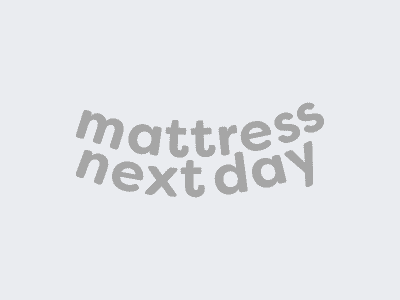


What's better, metal, or wooden bunk beds?
There are good points for both metal and wooden bunk beds.
Metal bunk beds
- Ideal for an uncluttered, minimalist interior design
- Super strong and lightweight using steel tubing
- Powder-coated rather than painted for a durable finish
- Cheaper than wooden bunk beds
Wooden bunk beds
- Classic and built to last
- Made from sustainably sourced pine or rubberwood
- Strong and stable
- Less chance of creaks and squeaks for a quieter night’s sleep
What bunk bed mattress size is right?
Any type of mattress works on a bunk bed, as long as it fits correctly and sits 16cm below the level of the safety barrier to ensure the child on the top bunk is safe. Specially made bunk bed mattresses are designed for use in bunk beds, as they’re thinner and lighter. This makes them easier to handle when you’re changing the sheets or moving the mattress around. Another great option if you looking to save space, is getting your child a shorty mattress, but make sure the size is compatible with your child's bunk bed.
| UK Bunk Bed Mattress Size | Best for: | Metric dimensions |
| Small single mattress | Most children’s bunk beds | 75cm x 190cm |
| Single mattress | Most standard bunk beds | 90cm x 190cm |
| Small double mattress | Triple-sleeper (bottom bunk) | 120cm x 190cm |
| Double mattress | Triple sleeper bunks (bottom bunk) and quadruple sleeper bunks (both top and bottom) | 135cm x 190cm |
Additional FAQs about bunk beds
Our Product Experts give the answers to the most common questions people have when choosing the best bunk bed.
What is the weight limit on a top bunk bed?
Most beds will have a designated weight limit on the instructions. On average, the weight limit for the upper bunk is around 200 lbs. So more than adequate for even older children.
What age is best for bunk beds for children?
This is entirely a question for parents to answer themselves, as there is no catch-all age that you can allow your children to sleep on a top bunk bed. We do recommend that you wait until children are at least six years of age, but always be guided by their confidence and your intuition.
How thick should a top bunk mattress be?
A top bunk mattress should sit 16cm below the level of the top of the safety barrier. Most bunk bed mattresses come in at around 14-15cm thick.
Can a top bunk collapse?
If you’ve followed the instructions to the letter, and as long as your children don’t use the top bunk as a trampoline, there is very little risk of the top bunk bed collapsing.
Can you put a regular mattress on a bunk bed?
You can put a regular mattress on the bottom bunk, but it’s recommended that you put a specially designed bunk bed mattress on the top level for safety reasons. They’re thinner and lighter but still offer plenty of support and comfort.
To find your perfect bunk bed mattress, as well as a great selection of bunk bed frames, check out the many options across our website - our MattressFinder quiz will help if you're stuck. Furthermore, if you are looking for a kid's mattress and unsure what to get for your children, check out our kids' mattress buying guide.
